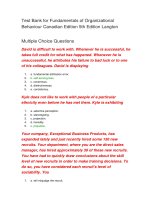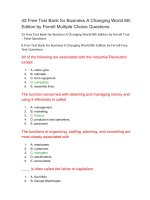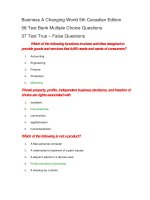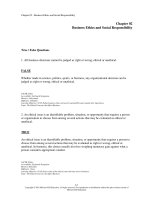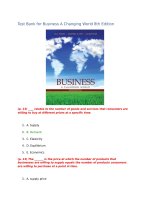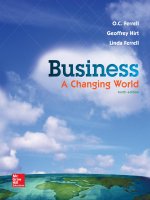95 test bank business a changing world 5th canadian edition
Bạn đang xem bản rút gọn của tài liệu. Xem và tải ngay bản đầy đủ của tài liệu tại đây (98.07 KB, 23 trang )
Business A Changing World 5th Canadian Edition
58 Test Bank Multiple Choice Questions
37 Test True – False Questions
Which of the following functions involves activities designed to
provide goods and services that fulfill needs and wants of consumers?
1.
Accounting
2.
Engineering
3.
Finance
4.
Production
5.
Marketing
Private property, profits, independent business decisions, and freedom of
choice are rights associated with
1.
socialism.
2.
free enterprise.
3.
communism.
4.
egalitarianism.
5.
humanitarianism.
Which of the following is not a product?
1.
A Mac personal computer
2.
A veterinarian's treatment of a pet's injuries
3.
A lawyer's advice in a divorce case
4.
Profits earned by businesses
5.
A checkup by a doctor
If a business is to be successful in the long run, it must treat its
customers, employees, and community with social _______.
1.
meetings
2.
responsibility
3.
agendas
4.
insight
5.
interests
All of the following are examples of natural resources, except:
1.
forests.
2.
human mental talent.
3.
minerals.
4.
nickel.
5.
fisheries.
The function concerned with obtaining and managing money and using it
effectively is called:
1.
management.
2.
marketing.
3.
finance.
4.
production and operations.
5.
personnel.
Which of the following questions are addressed by all economic
systems?
1.
What goods and services should be produced?
2.
How much of each good and service should be produced?
3.
Who will produce the goods?
4.
How should the goods and services be distributed?
5.
All of the answers are correct.
The goal of business is to earn
1.
respect.
2.
resources.
3.
a profit.
4.
responsibility.
5.
independence.
The difference between pure capitalism and modified capitalism is that
under
1.
pure capitalism there is less government regulation.
2.
modified capitalism there is less government regulation.
3.
pure capitalism there is more government regulation.
4.
either form of capitalism, government regulation is equal.
5.
none of the answers is correct.
Which of the following systems has the highest degree of competition?
1.
Communism
2.
Socialism
3.
Pure capitalism
4.
Modified capitalism
5.
Mixed economy
Which of the following countries best depicts a communist economic
system?
1.
Cuba
2.
Canada
3.
Russia
4.
Poland
5.
Hungary
If an economist is analyzing the quantity of goods or services that
businesses are willing to sell at different prices at specific times, then the
focus is on
1.
competition.
2.
pure competition.
3.
demand.
4.
supply.
5.
equilibrium.
All the following are factors of production used to make goods and
services except:
1.
natural resources.
2.
human resources.
3.
customers.
4.
capital.
5.
financial resources.
Most economic systems
1.
exist in a pure form.
2.
exist in a mixed form.
3.
are ineffective.
4.
create revolutions.
5.
give individuals freedom.
One of the best known Canadian marketing initiatives of all time is:
1.
The Air Miles Program
2.
Tim Hortons' "Roll up the Rim to Win"
3.
Petro-Points
4.
HBC's reward program
5.
President's Choice points
In which economic system(s) are basic services provided by the central
government?
1.
Communism and socialism
2.
Capitalism and socialism
3.
Communism and capitalism
4.
Socialism only
5.
Capitalism only
When a business fails or does not make a profit, _______ have the most to
lose.
1.
customers
2.
workers
3.
managers
4.
owners
5.
consumers
Businesses differ from non-profit organizations in that a business's focus
is on
1.
price.
2.
goods.
3.
profits.
4.
organization.
5.
plans.
The group of people to whom management activities most apply is
consumers.
1.
owners.
2.
bankers.
3.
government regulators.
4.
employees.
Communist societies
1.
appear to be efficient and equitable, at least in theory.
2.
have a high standard of living.
3.
seldom have consumer shortages.
4.
have only one class of people.
5.
do not spend much on defense.
Under a capitalist system, goods and services provided are determined by
all of the following except
1.
competition.
2.
supply.
3.
consumer demand.
4.
market forces.
5.
businesses owned by the government.
The functions of organizing, staffing, planning, and controlling are most
closely associated with __________.
1.
employees
2.
customers
3.
managers
4.
stockholders
5.
accountants
Socialism
1.
allows only private ownership of business.
2.
allows only government ownership of the factors of production.
3.
has government ownership of basic industries.
4.
is becoming more popular.
5.
all of the answers are correct.
Resources may be
1.
services.
2.
ideas.
3.
machines.
4.
human.
5.
concepts.
Socialist economies praise their egalitarianism, which means income and
social services are distributed
1.
to the elite only.
2.
to the poor only.
3.
equally.
4.
unequally.
5.
to the homeless.
Suppliers are generally willing to
1.
lower prices below costs.
2.
supply more at a higher price.
3.
demand more at a higher price.
4.
determine equilibrium price.
5.
supply more at a lower price.
All of the following are true in a communist economy except
1.
the means of production are owned by the government.
2.
the government chooses what will be produced.
3.
the government decides how the goods will be produced.
4.
supply is determined by central government planning.
5.
consumers have a wide choice of goods and services.
Factors of production are:
1.
resources used to produce goods and services.
2.
fixed resources.
3.
taxes.
4.
seldom in demand.
5.
free.
Advertising, personal selling, coupons, and sweepstakes are forms of
____.
1.
publicity
2.
promotion
3.
marketing research
4.
management activities
5.
the marketing mix
When purchasing a product, the consumer is actually buying its
anticipated benefits and the _________ it brings.
1.
satisfaction.
2.
price.
3.
costs.
4.
productivity.
5.
form.
58 Free Test Bank for Business A Changing World 5th
Canadian Edition by Ferrell Multiple Choice Questions
- Page 2
In the history of the Canadian economy, the period or stage following the
Industrial Revolution was known for its emphasis on
1.
service.
2.
technology.
3.
manufacturing.
4.
agriculture.
5.
both manufacturing and agriculture.
All of the following are associated with the Industrial Revolution, except:
1.
factories.
2.
railroads.
3.
farm equipment.
4.
computers.
5.
machines.
Agricultural commodities are usually sold under which competitive
environment?
1.
Monopoly
2.
Monopolistic competition
3.
Pure competition
4.
Oligopoly
5.
Pure capitalism
As women entered the workforce in increasing numbers, Canadians
began to pay others to do jobs for them which made their lives easier.
This began the transformation of the Canadian economy into a:
1.
service economy
2.
sluggish economy
3.
financial economy
4.
agricultural economy
5.
industrial economy
Supply and demand may be an efficient way to distribute resources,
1.
but it may not distribute resources equally among those who need them.
2.
but it doesn't allow the poor to get rich.
3.
although equilibrium price is determined by the government.
4.
but it helps inefficient producers to succeed.
5.
and it is always fair.
Using the supply and demand curves shown in the graph that follows,
what is the equilibrium price for soft drinks?
1.
35 cents
2.
45 cents
3.
50 cents
4.
55 cents
5.
75 cents
Countries measure the state of their economies to
1.
determine whether they are expanding or contracting.
2.
regulate wages and employment.
3.
let other nations know the state of their economic health.
4.
avoid taking corrective action.
5.
control government spending.
Economic contraction leads to:
1.
spending increases
2.
recession
3.
higher employment
4.
inflation
5.
deflation
If Chrysler raises the prices of its new models of pickup trucks by 4
percent and General Motors and Ford follow by raising prices by a similar
amount, then this is evidence of
1.
a monopoly.
2.
an oligopoly.
3.
pure competition.
4.
monopolistic competition.
5.
supply and demand.
When businesses can promote different features of their products and
consumers are willing to pay more for products containing the features
they desire, the competitive environment is probably
1.
pure competition.
2.
monopolistic competition.
3.
oligopoly.
4.
monopoly.
5.
pure capitalism.
Competition fosters efficiency because
1.
the government regulates prices.
2.
producers have to offer the best products at reasonable prices.
3.
supply depresses prices.
4.
all buyers have perfect knowledge.
5.
businesses can set whatever prices they want.
Time-pressed Canadians are increasingly:
1.
paying others to do their own home tasks
2.
relaxing
3.
sleeping
4.
reading
5.
reducing the time they spend at work
Inflation in Canada is typically measured by:
1.
Gross Domestic Product.
2.
The Consumer Price Index.
3.
Per capita income.
4.
Worker productivity.
5.
The Trade Balance
The early economy of Canada was marked by settlers who operated a
society primarily based on
1.
manufacturing.
2.
technology.
3.
sweatshops.
4.
information.
5.
agriculture.
A budget surplus, when a nation spends less than it takes in from taxes, is
the opposite of a(n):
1.
stagnant income.
2.
budget deficit.
3.
economic expansion.
4.
balance of trade.
5.
economic contraction.
Economic contraction occurs when
1.
more goods and services are demanded by consumers.
2.
spending declines and businesses cut back on production.
3.
a nation's standard of living remains stable over time.
4.
employment levels increase over time.
5.
prices begin to rise and incomes rise accordingly.
Much of the new debt accrued in Canada between 2008 and 2013 can be
attributed to:
1.
stagnant income.
2.
Canada's Economic Action Plan.
3.
economic expansion.
4.
balance of trade.
5.
poor monetary management.
Technological trends have gradually changed Canada to a(n) _____
economy focused on making life easier for busy consumers.
1.
manufacturing
2.
service
3.
agriculture
4.
technology
5.
marketing
The entrepreneur has been primarily associated with a willingness to
1.
stay conventional.
2.
follow others.
3.
take risks.
4.
be repetitive.
5.
be conservative.
Economic expansion occurs when
1.
fewer goods and services are produced than consumers demand.
2.
an economy is growing and people are spending more money.
3.
a nation's standard of living drops quickly.
4.
employment levels decline over time.
5.
prices begin to rise and incomes begin to fall.
Monopolies that function in a capitalistic economy are likely to have
prices determined by
1.
law of supply.
2.
law of demand.
3.
interaction of supply and demand.
4.
equilibrium interaction.
5.
government regulation.
Which competitive environment best describes the market for wheat, corn,
and cotton?
1.
Monopoly
2.
Monopolistic competition
3.
Pure competition
4.
Oligopoly
5.
Pure capitalism
Increased unemployment can reduce consumer demand for goods and
services, leading to
1.
economic contraction.
2.
inflation.
3.
deflation.
4.
a budget deficit.
5.
higher employment levels
All of the following are associated with the manufacturing economy,
except:
1.
buying on a time-payment plan.
2.
marketing.
3.
advertising.
4.
cable television.
5.
marketing research.
A continuing rise in prices over a period of time refers to
1.
inflation.
2.
economic expansion.
3.
a recession.
4.
economic contraction.
5.
stagflation.
When Walmart has a sale on digital cameras,
1.
consumers won't demand more digital cameras than normal.
2.
the store won't supply more digital cameras than it normally does.
3.
consumers will demand more digital cameras.
4.
the manufacturer will halt production of digital cameras.
5.
consumers will demand fewer digital cameras.
Which competitive environment best describes the market for Canadian
air travel?
1.
Monopoly
2.
Monopolistic competition
3.
Oligopoly
4.
Pure competition
5.
Pure capitalism
When Apple introduced the iPod portable digital music player, the price of
and demand for digital music players was high. As a result,
1.
other suppliers introduced digital music players to meet the demand.
2.
consumers stopped buying digital music players.
3.
manufacturers stopped producing digital music players.
4.
competition was not allowed to enter the market.
5.
the equilibrium price met supply.
37 Free Test Bank for Business A Changing World 5th
Canadian Edition by Ferrell True - False Questions
The focus of all marketing activities is customer satisfaction.
1.
True
2.
False
During a recession, unemployment is unusually low.
1.
True
2.
False
The Canadian Pacific Railway linked Canada from north to south.
1.
True
2.
False
A severe recession may turn into a depression.
1.
True
2.
False
Monopolistic competition exists when there is only one producer of a
product in a given market.
1.
True
2.
False
Since 1997, it has been common policy for the government of Canada to
run large budget deficits.
1.
True
2.
False
Managers coordinate resources to achieve organizational objectives.
1.
True
2.
False
Businesses have the right to keep and use their profits as they choose,
without limitations.
1.
True
2.
False
Finance is concerned with obtaining money and using it effectively.
1.
True
2.
False
Entrepreneurs risk their wealth, time, and effort to develop for profit an
innovative product or way of doing something.
1.
True
2.
False
A central issue of economics is how to fulfill consumers' unlimited
demand for goods and services in a world with limited resources.
1.
True
2.
False
A product's equilibrium price is constantly changing in response to
changes in economic conditions, availability of resources, and degree of
competition.
1.
True
2.
False
When a nation collects more from taxes than it spends, it has a budget
deficit.
1.
True
2.
False
Advertising first made consumers aware of differences in products and
prices in the marketing economy.
1.
True
2.
False
Free-market capitalism and laissez-faire capitalism are essentially the
same thing.
1.
True
2.
False
Human resources refer only to the mental abilities of people used to
produce goods and services; it is synonymous with knowledge.
1.
True
2.
False
Non-profit organizations such as the Canadian Cancer Society do not
engage in management, marketing, or finance activities.
1.
True
2.
False
Entrepreneurship is essential to a free-enterprise system.
1.
True
2.
False
An oligopoly exists when there are many small businesses selling one
standardized product.
1.
True
2.
False
Natural resources include land, minerals, water, and other gifts of nature
which are not made by humans.
1.
True
2.
False
Society demands ethical and socially responsible business behaviour
towards customers and investors only. There seems to be less of a
concern for other stakeholder groups including government regulators
and the environment.
1.
True
2.
False
In a free-market system, the government regulates business.
1.
True
2.
False
The goal of business activities is to earn a profit.
1.
True
2.
False
Economic expansion occurs when an economy is growing and people are
spending more money.
1.
True
2.
False
Capitalism is an economic system in which the government owns and
operates basic industries while individuals own most other businesses.
1.
True
2.
False
The equilibrium price is represented by the point where a product's supply
and demand curves intersect.
1.
True
2.
False
Inflation is a condition characterized by falling prices.
1.
True
2.
False
Profit is what it costs to make and sell a product.
1.
True
2.
False
Gross domestic product is the sum of all goods and services produced in
a country during a year.
1.
True
2.
False
Studying business will help you develop skills to employ in a future
career, if that career takes place in the country where you studied
business topics.
1.
True
2.
False
Demand is the quantity of goods and services that consumers are willing
to buy at different prices at a specific time.
1.
True
2.
False
Owners have little responsibility to provide funds for the operation of the
business.
1.
True
2.
False
Industrialization mostly occurred in Central Canada.
1.
True
2.
False
Products have tangible attributes only.
1.
True
2.
False
Most socialist nations are democratic.
1.
True
2.
False
Owners always manage their businesses themselves.
1.
True
2.
False
The standard of living rises because people have less money to spend.
1.
True
2.
False

